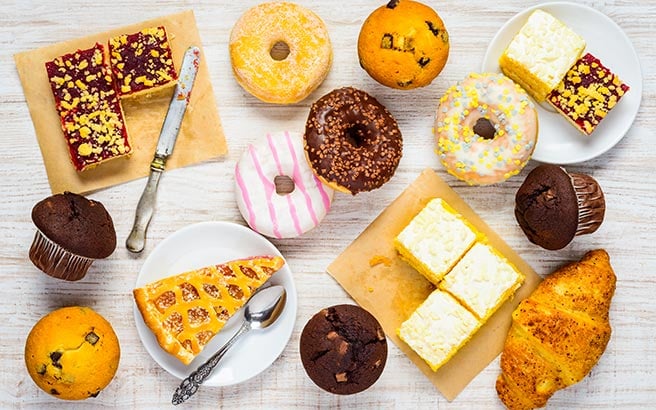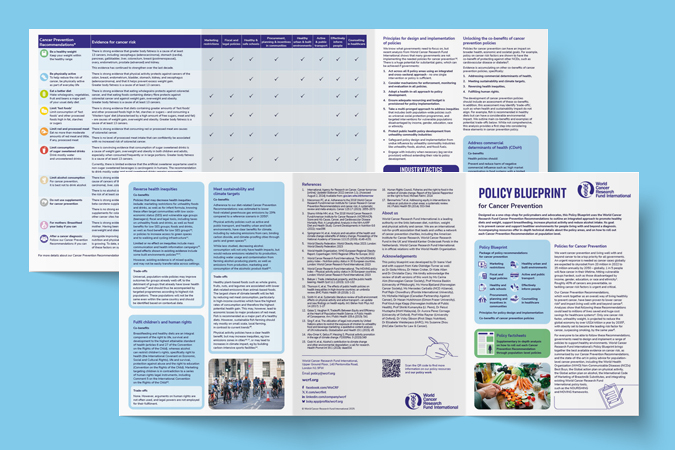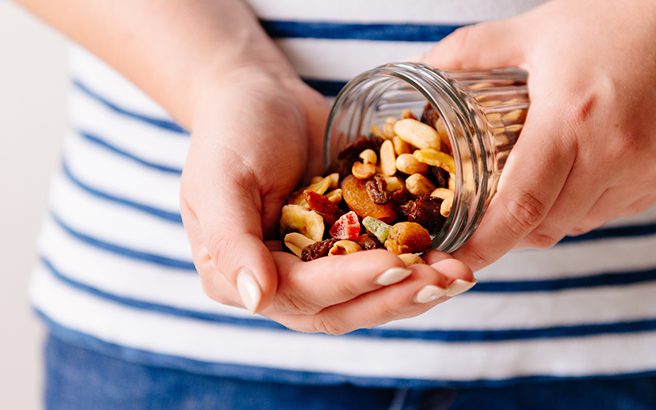One of World Cancer Research Fund’s Cancer Prevention Recommendations is to limit the amount of red and processed meat we eat.
But in the past few years the phrase “ultra-processed food” has been introduced and is now increasingly used to describe a specific category of food. A 2018 study found that more than 50% of the calories that an average person in the UK eats come from ultra-processed foods.
So what exactly is ultra-processed food, and should we be limiting it? Let us explain…
The level of processing that foods go through varies hugely. Common practices like baking homemade bread and pasteurising milk are examples of food processing and even chopping and boiling are processes. But these are rarely considered unhealthy.
The phrase “processed food” is commonly used when talking about commercial and industrial production of food and that’s where the phrase “ultra-processed food” has become more common.
How do you know what processes a product has gone through?
The original NOVA system of food classification was developed in 2010 by a Brazilian nutrition researcher, Carlos Monteiro, and his team, specifically to categorise the nature of industrial food processing. It was the first time that the concept of “ultra-processed food” was developed and coined.
The system has since evolved and now splits food products into four groups, based on how much processing they’ve gone through. The four groups in the NOVA system are:
1. Unprocessed and minimally processed foods
Unprocessed foods are fruit and vegetables, nuts, seeds, grains, pulses, beans and natural animal products, such as eggs, fish or milk.
Minimally-processed products contain no added fats, salt, sugar or other additives, and may have been crushed, roasted, frozen or boiled.
Examples include:
- frozen fruit and vegetables
- frozen fish
- shelled nuts
- dried fruit or mushrooms
- 100% fruit juice
- pasteurised milk
- no added sugar yoghurt
2. Processed culinary ingredients
This category includes ingredients that aren’t created to be eaten alone, and are often used alongside those in group 1. Examples include:
- oils
- fats such as butter
- vinegars
- sugars
- salt
3. Processed foods
This is where a product from group 2 – like salt, sugar, fat or vinegar – is added to one of those minimally-processed foods.
This category includes:
- many tinned goods, such as tomatoes, lentils and beans, tuna, chickpeas
- food kept in brine, like olives
- salted nuts
- cheese
It also includes smoked and cured meats (that haven’t been made with reconstituted meat).
4. Ultra-processed foods
This includes products that are typically made using industrial equipment and ingredients that break down the original food and then recombine them – often with artificial preservatives or other ingredients that aren’t found in a normal kitchen.
The list of foods that sit in this category is long and includes:
- pre-packaged meals (such as microwave dinners)
- industrialised bread
- breakfast cereals
- sweets, chocolate, biscuits and cakes
- sausages, chicken nuggets, veggie burgers
- soft drinks (eg cola, fruit drinks)
- crisps
- sweetened yoghurt
As mentioned in the introduction, 56% of the average British person’s calories come from this group, so it’s clear that “ultra-processed” has become the dominant category of food – in the UK, at least.
Is ultra-processed food harmful?
There are a number of health concerns related to ultra-processed food. Studies have shown that diets high in ultra-processed food tend to be linked with a higher risk of chronic disease (this is a recent review). And there has also been at least one large study that links excessive consumption of ultra-processed foods with increased cancer risk.
We don’t know for sure how ultra-processed food could affect health. The possibilities are that they tend to be lower in beneficial nutrients (eg vitamins and minerals) than less processed foods.
Some of the additives added during food processing are thought to be carcinogenic, for example, nitrites which are commonly added to processed meats.
They’re often lower in fibre, too, which is a result of the industrial processes that break down the structure of the original product, and higher in sugar and salt.
Our reviews found strong evidence that a “Western” diet, characterised by consuming a lot of ultra-processed food, is associated with weight gain. We also know that overweight and obesity are a cause of at least 13 types of cancer.
But it’s the overall diet that is most important, rather than any one food, food group or nutrient. We encourage people to consume a healthy balanced diet that contains plenty of wholegrains, vegetables, fruit and beans, and which limits “fast foods” and other processed food high in fat, starches and sugars, red and processed meat, and sugar sweetened drinks.
Reducing the amount of ultra-processed food you eat is one way of moving closer to eating in line with our Cancer Prevention Recommendations. Ultra-processed food seems to be a good way of characterising the healthiness of the diet – a diet low in these foods tends to be healthier overall.
How do I recognise ultra-processed food?
- One of the easiest ways is to look at the ingredients list of products. For example, if you made a loaf of bread at home, you’d typically use 4 or 5 ingredients (flour, yeast, salt, water, maybe a little oil). Industrial bread (that you’d typically find in a supermarket) has two-to-three times that number, and often the ingredients are of inferior quality.
- If you don’t recognise the name of an ingredient, it’s often an additive and a sign of an ultra-processed product.
- Look at the traffic light labels on the front of food – those that are all, or mostly, red indicate high levels of sugar, fat and salt, and are common signs of an ultra-processed food.
- A long shelf life on a supposed “fresh” food – often found in the chiller cabinet – usually means that preservatives have been added to the product, indicating ultra-processed.
This isn’t always the case – for example, bacon isn’t ultra-processed (it is classified as “processed” because the meat hasn’t been reconstituted), but we recommend limiting bacon because of the link between red and processed meat and colorectal cancer.
How do I avoid ultra-processed food?
- Cook from scratch at home as often as you can – if you know what’s going into your breakfast, lunch and dinner, then you are in control.
- Read the ingredients list – products with more than 5 ingredients tend to be ultra-processed.
- Swap fizzy or sugary drinks for unsweetened tea, coffee and water.
- Snack on fruit or seeds, rather than pre-packed snacks (for healthier alternatives try the oat berry breakfast bars or chocolate and orange frozen yoghurt bar).
- Avoid food high in sugar, fat and salt – keep an eye on the traffic light labels.
- Try to eat a diet that comprises mainly wholegrains, pulses (such as beans and lentils), fruit and vegetables.
What is WCRF’s view on ultra-processed food?
At World Cancer Research Fund International, we’ve highlighted the risks of consuming foods that are high in fat, salt and refined carbohydrates for some years. Considering the overall diet, along with other healthy behaviours, is the key to reducing cancer risk.
Reducing the amount of ultra-processed food you eat is one way of moving to a healthier diet and meeting our Cancer Prevention Recommendations.




